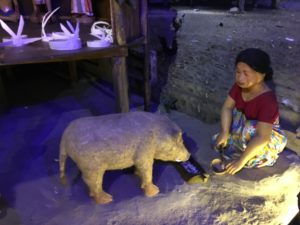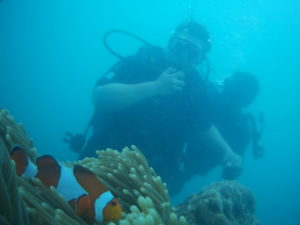Andaman and Nicobar Islands: History and Adventure
Day 2:
It started with a walk down the history of Andaman and Nicobar Islands.
Kalapani Museum
We visited the Kalapani Museum in morning. It is the only private museum in India, run by Mr. Mukeshwar Lal. He is a documentary maker and an avid historian of the Andaman and Nicobar Islands. Created and maintained very well, one gets an in-depth insight into the importance of Andaman from a historical, geographical and strategic POV. The museum has an excellent collection of original documents, historical photographs, documents and detailed information starting from around 1700 till 2014. I would suggest to cover this place within the first two days since it gives a lot of perspective for the Islands visited on rest of the trip. Reserve at-least 3 hours for this museum. The information shared by Mukeshwar Lal and his team is unbiased, quite accurate and showcases his passion for preserving the history of this historically significant part of India.
The tour starts from the introduction of Andaman and Nicobar Island tribes. The Andaman Islands are home to 4 tribes of African origin viz. Onges, Great Andamanese, Jarawa, Sentinelese and the Nicobar Islands are home to 2 tribes of Mongolian origin viz. the Shompen and Nicobarese. We get to see rare pictures, models of their homes, insight into their lives, culture, traditions and present state.



The second floor covers the period of British rule in Andaman with incidents like the building of first jail on Viper Island, cellular jail history, freedom fighters serving Kaalapani in Andaman, building of Ross Island, battle of Aberdeen, the British Generals viz. Havelock, Neil, David Barry.
It also covers in detail the history of India house , meetings conducted by Veer Savarkar in India house , his capture and escape from England, his jump near Marseilles, France (one that shook the world), his stay in cellular jail and his contribution to Indian freedom struggle.
The third floor covers the takeover of Andaman Islands by Japan, subsequent imprisonment of Indians for political reasons and the punishments given to them, the struggle under Japanese rule, the currency during those times, the visit by Netaji Subhash Chandra Bose etc.
Andaman came again under British rule after 1945. Thus, when India became independent, Andaman became a part of India since by then many Indians were residing on the Islands and preferred to stay as a part of India.
The last session, a small documentary followed by the Q&A session with the owner is a delightful part. Hats off to his perseverance to keep the history alive and share it with the next generations.
Post the museum visit we had a lunch break followed by cruise to Havelock Island. The ocean tide wasn’t rough so the cruise was a pleasant one. Post reaching Havelock, we were hit by rains and decided to stay indoors for the rest of the evening mingling with each other over games.
Day 3:
Due to bad weather none of water sports activities at Elephant beach were open. Instead we visited Kalapatthar beach which has black rocks along the beach’s coastline.
Kalapatthar Beach
A turquoise blue sky, bluish green transparent cold water and big waves greeted us with a wide smile. The waves sometimes seemed calm, while at other times angry , restless and for few moments ferocious. The beach sand was filled with coral pieces , literally piercing our feet soles.
I would say this beach , in particular seemed like rebellious , unlike those of Konkan near Arabian Sea and the pebble ones we had visited at Brighton. It seemed as if time stood still while we were there.
I am surely going to miss this beach.
We were off to Radhanagar beach in the evening. A golden soft sand beach, ideal for an evening run or for simply sitting by the beach and experiencing calmness dear ones.
There are no water sports at Radhanagar beach, although you can swim. Locals say that there are crocodiles lurking near the mangroves and it’s not advisable to venture near them.
Scuba Dooba Do
On the ride to hotel, we were informed about the weather being fine the next day for scuba diving.
Initially, me and DH were reticent but later in night we decided to give it a shot. We were given the consent form and 5 of us from the group were completely scared after reading the terms and conditions to perform the activity.
I, for one, was seriously in a dilemma as I always end up with a swimmer’s ear post underwater swimming. Somehow, the next morning I gathered the courage and decided to go.
If not now, then when, the philosophy of my life 😊
We were given a ZNMD kind of 15-minute training with the scuba diving gear at around 5.30 am in the morning. The most difficult part was the first five minutes underwater in the training session when you realize that you need to learn to breathe using the oxygen mask and not your nose. Due to previous day rains, the water till 1-meter deep was muddy hence the training session was scarier as we could not see anything underwater. We were told not to swim on our own as the instructor was supposed to guide us. We learnt the ok, not ok, up, down signals for communication, practiced them a bit and then were taken inside the sea.
As one goes below sea level, one needs to blow through their nose to equalize the pressure in the ears, an ear pain means the ear drum is under pressure. Due, to the swimmer’s ear thing, after diving down few meters I started getting ear pain. I signaled my instructor to take me up as it was something, I am absolutely uncomfortable with. He took me at the surface and asked me what’s wrong. I shared my issue and he told me to equalize every time he signals rather than meter wise. He told me to lie flat on my back and look at the sky for 5 minutes while floating on water. That calmed me and we were back diving inside the sea. Per his instructions, I equalized every time he signaled to do so.
Few meters down the sea and the water started becoming clear. I was able to spot corals of different colors, biomass on the reefs, different types of marine creatures and also my favorite the rainbow fish (depicted as Nemo). I dived around 10 meters below sea level, was photographed with the rainbow fish and also got to have a small recording of my scuba dive. Needless to say, it was one of the most mesmerizing experience of my life.


Just a caution to those who wish to scuba dive, in case you have a cold or had a cold a week before the dive, check with the instructor before diving. If an infection is present, even though you equalize you might end up with an ear infection.
Off to Neil Island
Post the dive and breakfast, we hurried to the jetty for our boat ride to Neil Island. Due to the rains the previous night, we were in for a rough sea ride. Most of us got sea sickness and were just waiting to reach the Island. Stay at Neil Island was just to wind down with a short visit to the Bharatpur beach.
In case, you miss the water sports, snorkeling or scuba diving at Havelock Island, you can do it at Neil Island too.
For those who have fear for going under water, taking a glass boat ride is a good option to explore marine life.
For those who do not wish to do scuba diving but still want to have a similar experience can opt for a sea walk wherein one wears an astronaut like helmet and diver’s suit under sea and walks on the ocean floor.
Back to Port Blair on Day 5
This involved a pleasant boat ride from Neil Island to Port Blair. Evening was spent shopping for souvenirs for myself and my dear ones. The National Emporium run by Andaman Local Body has a variety of hand crafted goods. Ones I bought were hand-painted necklace and earring sets made from sea shells, Nicobar hut model made from coconut shells, few magnets (a must for my collection), salt and pepper shakers made from Conch Shells, some handwoven baskets for my kitchen use etc.
Thought for the day
After the scuba dive and sea travel, I have a new respect for professionals who work below the sea and are on boats in oceans for days with no land in sight. It’s not easy to survive in the conditions we experienced and then work on top of that.
Also , that we need more private museums and folks like Mukeshwar Lal who are passionate to give a factual, unbiased and accurate details about history of our nation.
